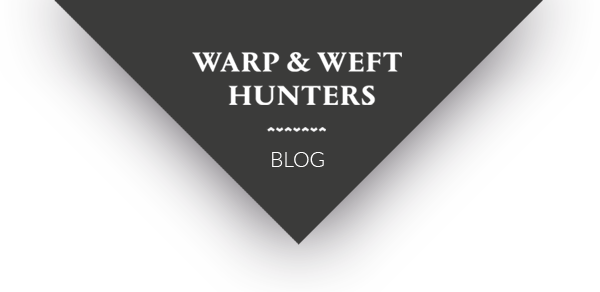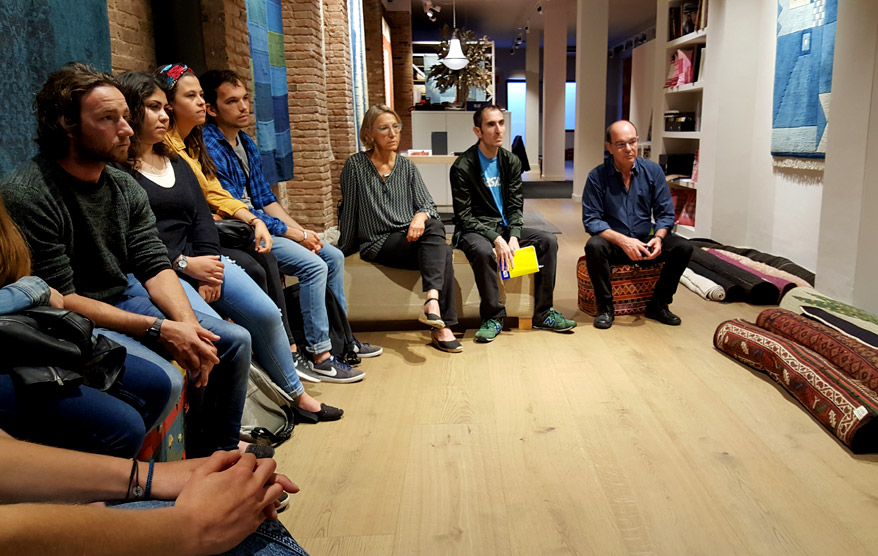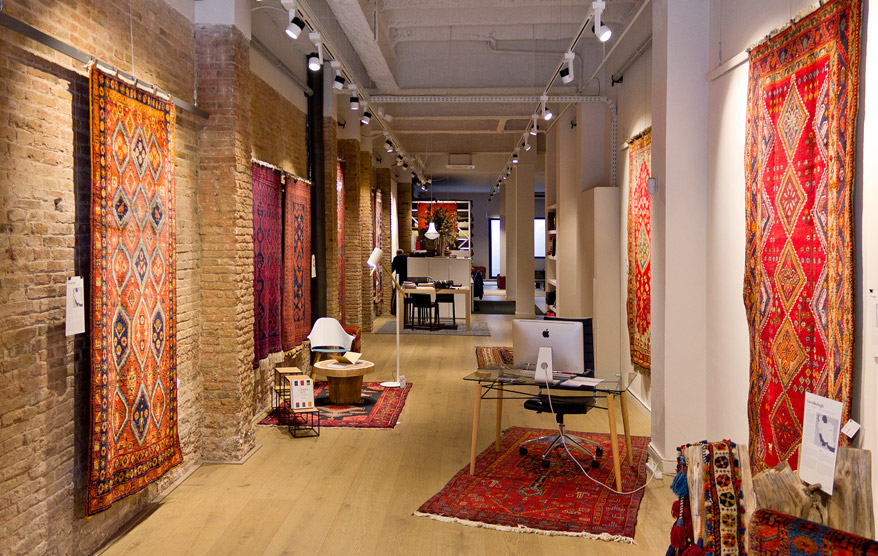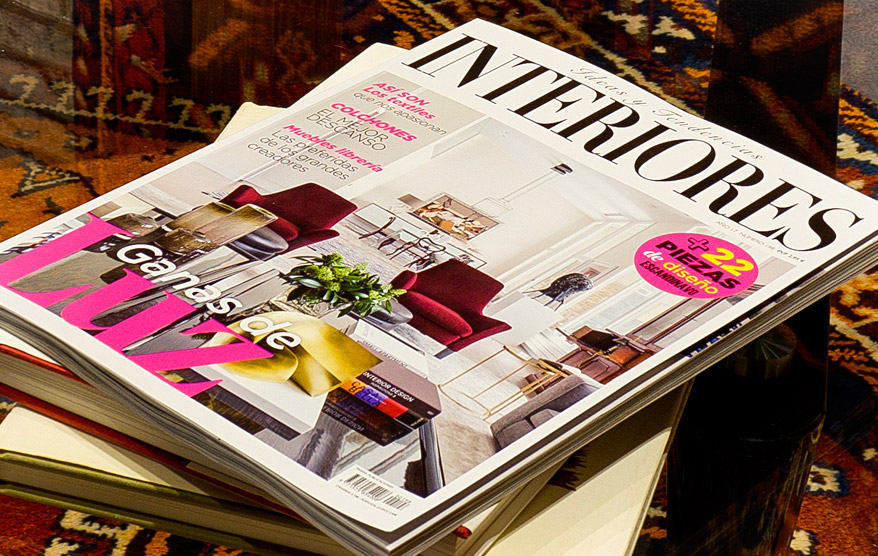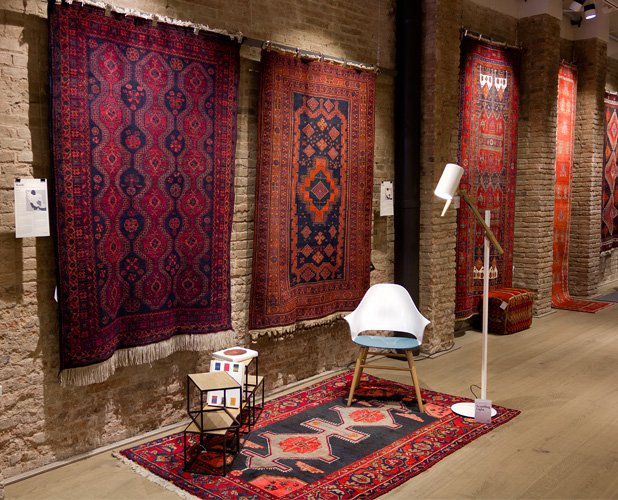
Between the 10th of March and the 7th of April we put up in our gallery the Nomadic Looms collection. Our first collection in 2017 was a compound of vintage tribal carpets with a great aesthetic power. All the pieces were created by the nomadic peoples from the south and west of Iran. Now you can virtually visit this collection.
Khaar Varamin
60336 — 140 x 230 cm. — c. 1950 — 100 % Wool
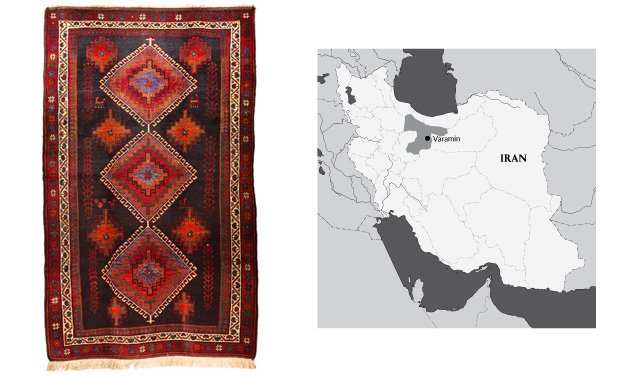
The name of this carpet family comes from the city of Varamin, south of Tehran, where the nomadic people that wove it live. This tribes are linked to the Shahsavan ethnic group, that originally came from the Caucasus and Anatolia, which still keeps it own millenarian traditions and languages.
This rug is a handmade piece with a great personality thanks to its colours and motifs. It is formed by three main diamonds, with the characteristic outline made of white ‘hooks’. The green-grey colour of its internal border is definitely rare.
Khaar Varamin
60289 — 133 x 250 cm. — c. 1930 — 100 % Wool
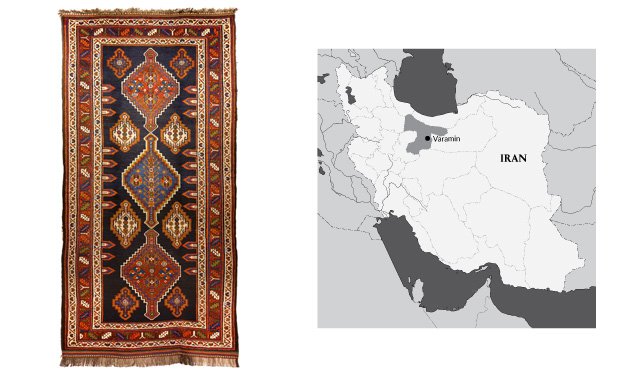
The name of this carpet family comes from the city of Varamin, south of Tehran, where the nomadic people that wove it live. This tribes are linked to the Shahsavan ethnic group, that originally came from the Caucasus and Anatolia, which still keeps it own millenarian traditions and languages.
This carpet is certainly old. It is something we can state thanks to the two-colour wool from its fringes (the warp) and the fact that we can still see an Iranian leaded seal on the left border, used it the region in the first half of the Twentieth century. In spite of its age, this Khaar Varamin is in a great state of preservation thanks to the robust weaving technique and the exceptional quality of its wool and natural dyes.
Kakerberu
60581 — 140 x 283 cm. — c. 1960 — 100 % Wool
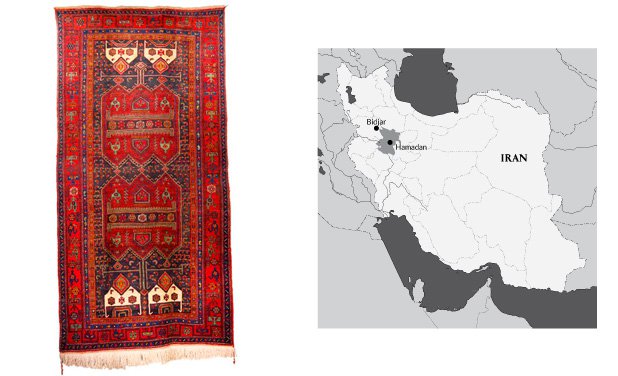
We call Kakerberu or Kakaberu the carpets woven by Iranian Kurdish settlements located on the mountains between Bijar and Hamadan. These pieces are not part of a single family of rugs but a mixture of carpets with different features coming from the Bijar and Kolyayee traditions. They get the name of ‘Kakerberu’ when they reach the Hamadan bazaar and they are sold internationally.
This Kakerberu is a rather unusual piece: its knots are very tight and fine and its weft are of exceptional robustness. It shows two characteristic motifs: the traditional ‘teapot’ symbol, here in green, related to the Kurdish people; and the special representation of the ‘governor’s throne’, or Takht-e-Jamshid, in the upper and lower parts of the carpet, in white.
Kouhi
60539 — 133 x 187 cm. — c. 1970 — 100 % Wool
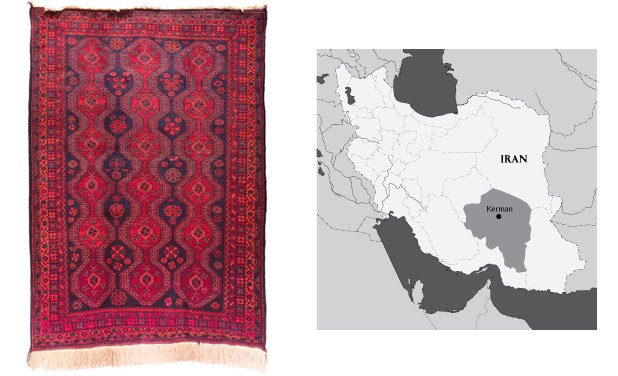
The word Kouh-e means ‘peak of the mountain’ in farsi. It is a kind of rug produced by the Afshar nomadic tribes, who live in the south of the Kerman province. Its language is of Turkish origin and they are linked to Anatolia but they, as a nation, were forced to migrate during the Fifteenth and the Sixteenth centuries.
This rug uses cotton for its warp (the fringes) and weft and, therefore, is not very old. The main motifs are the three diamond chains coloured in blue and purple. The observer will find many tiny symbols and icons all over the carpet, as well as flower representations, probably influenced but the region’s tradition.
Kouhi
60357 — 140 x 195 cm. — c. 1960 — 100 % Wool
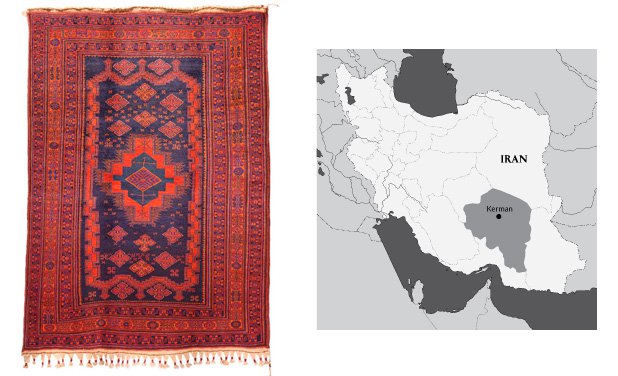
The word Kouh-e means ‘peak of the mountain’ in farsi. It is a kind of rug produced by the Afshar nomadic tribes, who live in the south of the Kerman province. Its language is of Turkish origin and they are linked to Anatolia but they, as a nation, were forced to migrate during the Fifteenth and the Sixteenth centuries.
Many features point out that this is an old carpet: it’s internal structure (warp and weft) is made of wool and its fringes are tied in braids, a coarse and traditional trait. The power and beauty of its central medallion and the weaving expertise required in order to craft its borders makes this an exceptional piece. The lower and upper part of the central section show three red appendix, very common in the Afshar region.
Savojbolagh
60213 — 122 x 245 cm. — c. 1930 — 100 % Wool
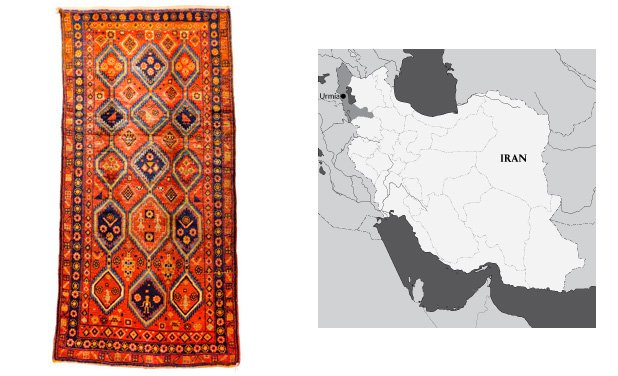
The Savojbolah or Suaj-Bolagh carpets are woven by Kurdish settlements in the west of the Urmia lake. These people cross the Iran-Irak several times per year because of the migrations because of their nomadic way of life.
We can state that this is an old rug thanks to the wool fringes, a feature that shows the internal structure (warp and weft). The knotting of this carpet is scarce and imprecise but it’s pictorial strength is outstanding and the quality of its wool is brilliant. Visually, the three rhombus stripes seek some symmetry but the many little motifs dispersed all over the composition (you can spot three human silhouettes) outstandingly breaks the consistency. Nothing of this kind is being woven nowadays.
Taleghan
60358 — 150 x 278 cm. — c. 1960 — 100 % Wool
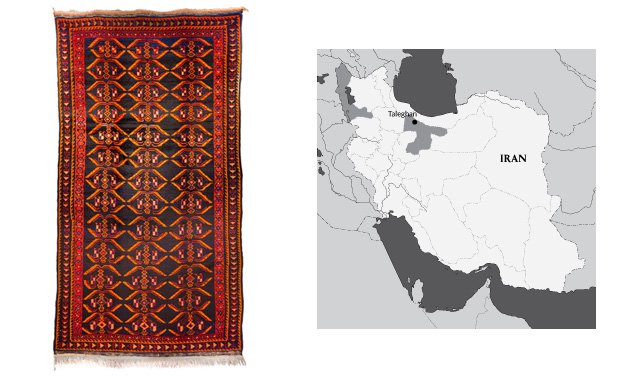
The Talegan, or Taleqan, carpets are woven in the valleys surrounding the city of Talegan. It is located in the midst of the Elburz mountains, northwest of Tehran and south of the Mazandaran region.
This is an unusual piece because of its visual elements. On one hand, the composition is uniform and regular. The composition repeats the same motif all over the carpet whilst the Taleghan carpets usually have a medallion in the centre. On the other hand, its borders are rather unique as it is possible to relate them with other Caucasian edging. The saturated orange dye generates a visual effect similar to the dynamic colour combinations.
Taleghan
60627 — 128 x 240 cm. — c. 1950 — 100 % Wool
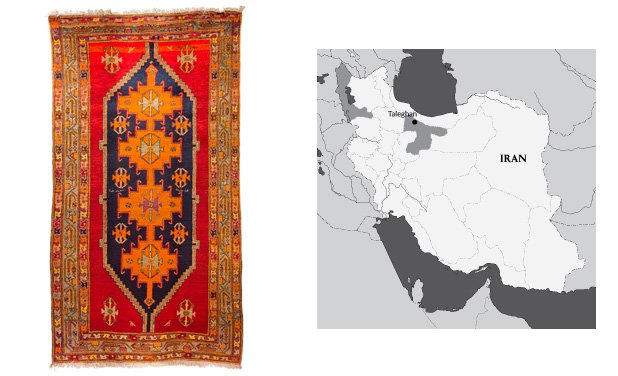
The Talegan, or Taleqan, carpets are woven in the valleys surrounding the city of Talegan. It is located in the midst of the Elburz mountains, northwest of Tehran and south of the Mazandaran region.
This piece does have a central medallion and follows the usual visual structure of this carpet family. Its use of colours is, though, very original: orange, purple, blue and green-grey. In the midst of the carpet one can read ‘Mohammed Reza’, possibly a local tribal leader.
Qashgai
60282 — 150 x 235 cm. — c. 1960 — 100 % Wool
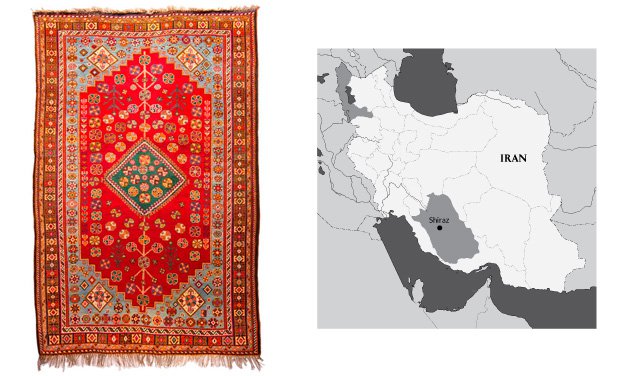
The Qashqai tribes live in the northern valleys of the city of Shiraz, capital of the Fars region. Their nomadic way of life makes them inhabit the cool mountain in the summer and the warm and low plains in the cold season.
This carpet has an internal structure (warp and weft) made of wool, a typical trait from coarse and traditional craft. Its composition with tens of flower motifs are distributed around the main medallion to, as they say, represent the old gardens from the royal palaces. It’s wool is of a great quality with very saturated red, green and blue colours.
Songhor
60325 — 142 x 275 cm. — c. 1950 — 100 % Wool
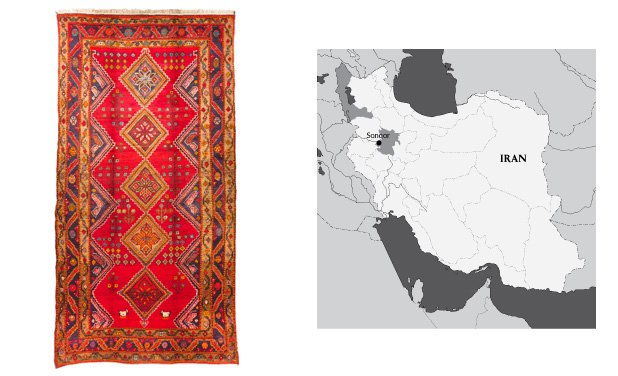
The Songhor are carpets crafted by the Kolyayee tribes that live on the west of Sonqor.
This carpet has a central medallion formed by five vertical diamonds. Around them one can find a red field, full of flower motifs – except the lower part. It is certainly very unusual to find the two sheep knotted in the lower part of this rug, possibly a homage to these animals. The border is quite common: it is a geometric interpretation of intertwined flowers.
Savojbolagh
60639 — 121 x 208 cm. — c. 1940 — 100 % Wool
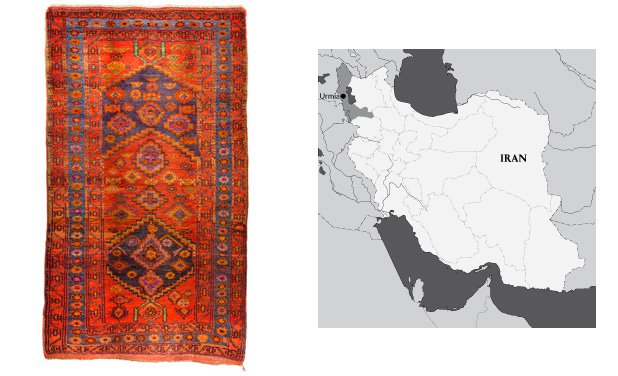
The Savojbolah or Suaj-Bolagh carpets are woven by Kurdish settlements in the west of the Urmia lake. These people cross the Iran-Irak several times per year because of the migrations because of their nomadic way of life.
This piece’s warp and weft is made of wool, a common material in its time of production. Visually, it is a very unique carpet, with an extraordinary chromatic power. The abash, or the wool’s color variation caused by the natural dyes, confers to the composition a graphic strength absolutely unusual. Nothing of this type is being woven anymore.

